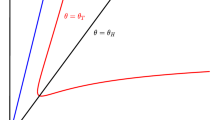Abstract
In this paper, a class of predator–prey model with nonlinear diffusion and time delay is considered. The stability is investigated and Hopf bifurcation is demonstrated. Applying the normal form theory and the center manifold argument, we derive the explicit formulas for determining the properties of the bifurcating periodic solutions. Some numerical simulations for justifying the theoretical analysis are also provided. Finally, main conclusions are included.


Similar content being viewed by others
References
Baek H, Lim YD. Dynamics of an impulsively controlled Michaelis–Menten type predator-prey system. Commun Nonlinear Sci Numer Simulat. 2011;16(4):2041–53.
Beretta E, Takeuchi Y. Convergence results in SIR epidemic model with varying populations sizes. Nonlinear Anal. 1997;28(12):1909–21.
Bhattacharya S, Martcheva M. Oscillations in a size-structured prey-predator model. Math Bios. 2010;228(1):31–44.
Cui GH, Yan XP. Stability and bifurcation analysis for a two-competitor/one-prey system with two delays. J Korean Math Soc. 2011;48(6):1225–48.
Genik L, Van den Driessche P. A model for disease without immunity in a variable size population. Can Appl Math Quart. 1998;6(1):5–16.
Hale J. Theory of functional differential equation. New York: Springer-Verlag; 1977.
Hassard B, Kazarino D, Wan Y. Theory and applications of Hopf bifurcation. Cambridge: Cambridge University Press; 1981.
Hethcote HW. The mathematics of infectious diseases. SIAM Rev. 2000;42(4):599–653.
Hou J, Teng ZD. Continuous and impulsive vaccination of SEIR epidemic models with saturation incidence rates. Math Comput Simulat. 2009;79(10):3038–54.
Li GH, Jin Z. Global stability of an SEI epidemic model. Chaos, Solitons Fractals. 2004;21(4):925–31.
Li GH, Jin Z. Global stability of an SEI epidemic model with general contact rate. Chaos, Solitons Fractals. 2005;23(3):997–1004.
Li MY, Muldowney JS. Global stability for the SEIR model in epidemiology. Math Biosci. 1995;125(2):155–64.
Li XZ, Zhou LL. Global stability of an SEIR epidemic model with vertical transmission and saturating contact rate. Chaos, Solitons Fractals. 2009;40(2):874–84.
Meng XZ, Chen LS, Cheng HD. Two profitless delays for the SEIRS epidemic disease model with nonlinear incidence and pulse vaccination. App Math Comput. 2007;186(1):516–29.
Meng XZ, Chen LS, Cheng HD, Jiao JJ, Chen LS. Two profitless delays for an SEIRS epidemic disease model with vertical transmission and pulse vaccination. Chaos, Solitons Fractals. 2009;40(5):2114–25.
Piyawong W, Twizell EH, Gumel AB. An unconditionally convergent finite-difference scheme for the SIR model. Appl Math Comput. 2003;146(2–3):611–25.
Ruan SG, Wei JJ. On the zero of some transcendental functions with applications to stability of delay differential equations with two delays. Dyn Contin Discrete Impuls Syst Ser A. 2003;10(1):863–74.
Sen M, Banerjee M, Morozov A. Bifurcation analysis of a ratio-dependent prey–predator model with the Allee effect. Ecol Complex. 2012;11:12–27.
Song XY, Li SL, Li A. Analysis of a stage-structured predator-prey system with impulsive perturbations and time delays. J Korean Math Soc. 2009;46(1):71–82.
Wang X, Tao YD, Song XY. Pusle vaccination on SEIR epidemic model with nonlinear incidence rate. Appl Math Comput. 2009;210(2):398–404.
Wang WY, Pei LJ. Stability and Hopf bifurcation of a delayed ratio-dependent predator-prey system. Acta Mech Sin. 2011;27(2):285–96.
Xu CJ, Liao MX, He XF. Stability and Hopf bifurcation analysis for a Lokta-Volterra predator-prey model with two delays. Int J Appl Math Comput Sci. 2011;21(1):97–107.
Xu CJ, Tang XH, LiaoMX. Stability and bifurcation analysis of a delayed predator–prey model of prey dispersal in two-patch environments. Appl Math Comput. 2010;216(10):2920–36.
Xu CJ, Tang XH, Liao MX, He XF. Bifurcation analysis in a delayed Lokta-Volterra predator-prey model with two delays. Nonlinear Dynam. 2011;66(1–2):169–83.
Yang K. Delay differential equations with applications in population dynamics. San Diego: Academic; 1993.
Zhou XY, Shi XY, Song XY. Analysis of non-autonomous predator-prey model with nonlinear diffusion and time delay. Appl Math Comput. 2008;196(1):129–36.
Acknowledgments
This work is supported by the National Natural Science Foundation of China (no. 11261010), Soft Science and Technology Program of Guizhou Province (no. 2011LKC2030), Natural Science and Technology Foundation of Guizhou Province (J[2012]2100), Governor Foundation of Guizhou Province ([2012]53), Natural Science and Technology Foundation of Guizhou Province (2013) and Doctoral Foundation of Guizhou University of Finance and Economics (2010).
Author information
Authors and Affiliations
Corresponding author
Rights and permissions
About this article
Cite this article
Xu, C., Li, P. Bifurcation Behaviors Analysis on a Predator–Prey Model with Nonlinear Diffusion and Delay. J Dyn Control Syst 20, 105–122 (2014). https://doi.org/10.1007/s10883-013-9208-1
Received:
Published:
Issue Date:
DOI: https://doi.org/10.1007/s10883-013-9208-1




